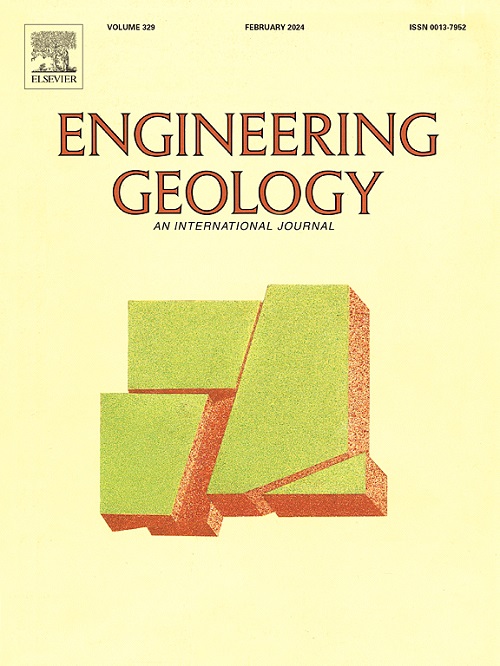岩体统计力学弹塑性模型:理论与验证
IF 6.9
1区 工程技术
Q1 ENGINEERING, GEOLOGICAL
引用次数: 0
摘要
节理岩体的变形预测是岩石力学中的关键问题之一。在连续介质力学的框架内合理描述节理集对节理岩体变形的影响一直是科学家和工程师追求的目标。为了实现这一目标,建立了岩体统计力学等效弹性本构模型。然而,由于该模型最初没有考虑岩体的塑性变形,其在岩石工程中的应用一直受到制约。本文将经典的SMRM弹性理论与经典的Mohr-Coulomb强度准则相结合,建立了SMRM模型的弹塑性理论。然后,通过一系列节理岩体的解析解和实验测试,广泛验证了所提出的弹塑性SMRM模型的可靠性。结果表明,所建立的SMRM弹塑性模型能够有效地考虑节理面的空间、力学和几何特征,并能有效地描述节理的密度和方向对节理岩体强度和变形的影响。本研究提出的弹塑性SMRM模型有可能为某些岩石工程问题提供新的解决方案。本文章由计算机程序翻译,如有差异,请以英文原文为准。
Elastoplastic model of statistical mechanics of rock masses (SMRM): Theory and verification
The prediction of the deformation of jointed rock masses is one of the critical problems in the discipline of rock mechanics. Reasonably describing the effect of joint sets on the deformation of jointed rock masses within the framework of continuum mechanics has always been a goal pursued by scientists and engineers. An equivalent elastic constitutive model, named the statistical mechanics of rock masses (SMRM), had been developed to achieve the goal. However, since this model of SMRM initially did not consider the plastic deformation of rock masses, its application in rock engineering had always been constrained. In this study, an elastoplastic theory of the SMRM model is established by combining the classical elastic theory of SMRM and the classical Mohr-Coulomb strength criterion. Then, the reliability of the proposed elastoplastic SMRM model is extensively verified through a series of analytical solutions and experimental tests for jointed rock masses. It is indicated that the proposed elastoplastic SMRM model can effectively consider the spatial, mechanical and geometric characteristics of joint planes, and it can also effectively describe the influence of the density and orientation of joints on the strength and deformation of jointed rock masses. The elastoplastic SMRM model proposed in this study could potentially provide a new solution for some rock engineering problems.
求助全文
通过发布文献求助,成功后即可免费获取论文全文。
去求助
来源期刊

Engineering Geology
地学-地球科学综合
CiteScore
13.70
自引率
12.20%
发文量
327
审稿时长
5.6 months
期刊介绍:
Engineering Geology, an international interdisciplinary journal, serves as a bridge between earth sciences and engineering, focusing on geological and geotechnical engineering. It welcomes studies with relevance to engineering, environmental concerns, and safety, catering to engineering geologists with backgrounds in geology or civil/mining engineering. Topics include applied geomorphology, structural geology, geophysics, geochemistry, environmental geology, hydrogeology, land use planning, natural hazards, remote sensing, soil and rock mechanics, and applied geotechnical engineering. The journal provides a platform for research at the intersection of geology and engineering disciplines.
 求助内容:
求助内容: 应助结果提醒方式:
应助结果提醒方式:


